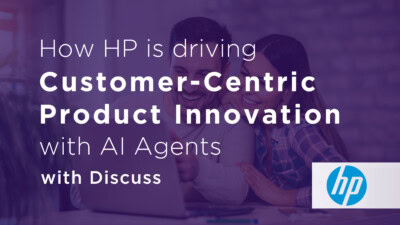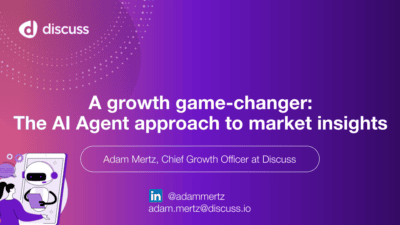3 Ways to Design for Empathy & Human Centricity

By Adam Mertz, Chief Growth Officer at Discuss
Introduction
I recently had the opportunity to moderate a compelling discussion between Sarah Tomasaitis, Suntory’s Director of Consumer & Shopper Insights, and Senem Guler Biyikli, PhD, a leading Analyst from Forrester. Their session, From Apathy to Empathy: The 3 Steps to Design for Human Centricity at Scale, shed light on how organizations can eliminate the past pains of conducting qual in this new era of human centricity. In this blog, I’ll highlight the key takeaways from their conversation.
Current Challenges in Human Centricity
Achieving human centricity is no easy feat. We often hear from global brands and research agencies that it’s costly, complex, and hard to piece together on a global scale.
With so many moving parts – different tools, technologies, and third-party vendors – it’s like juggling flaming torches. In fact, when we polled our virtual audience, most were using 5+ agencies or technologies just to gather customer feedback.
Add to that the time and effort involved at every step: recruiting the right audience, scheduling sessions, involving observers, executing the research, and then trying to synthesize all of the insights from the conversations.
We also have to factor in that in-depth insights in qualitative research has changed more in the last three years than it has in the previous thirty. Before COVID, not much had changed in qual. But with face-to-face interactions off the table, new technologies for DIY methods and asynchronous research took off. Now, generative AI is helping us scale human centricity, prompting brands to refine their approach, thinking about research hubs and incorporating both live and asynchronous research.

Forrester Analyst Perspective: Empathy and Designing for Human Centricity
Defining Empathy
Senem Guler Biyikli, PhD, offers a powerful definition of empathy: “The perception that an organization is emotionally connected to its customers, employees, and partners and understands and shares their feelings and experiences.”
She provides the example of US banking customers who feel understood by their bank are almost 2x more likely to stay with their bank, prefer it over competitors, recommend it, and use additional services.
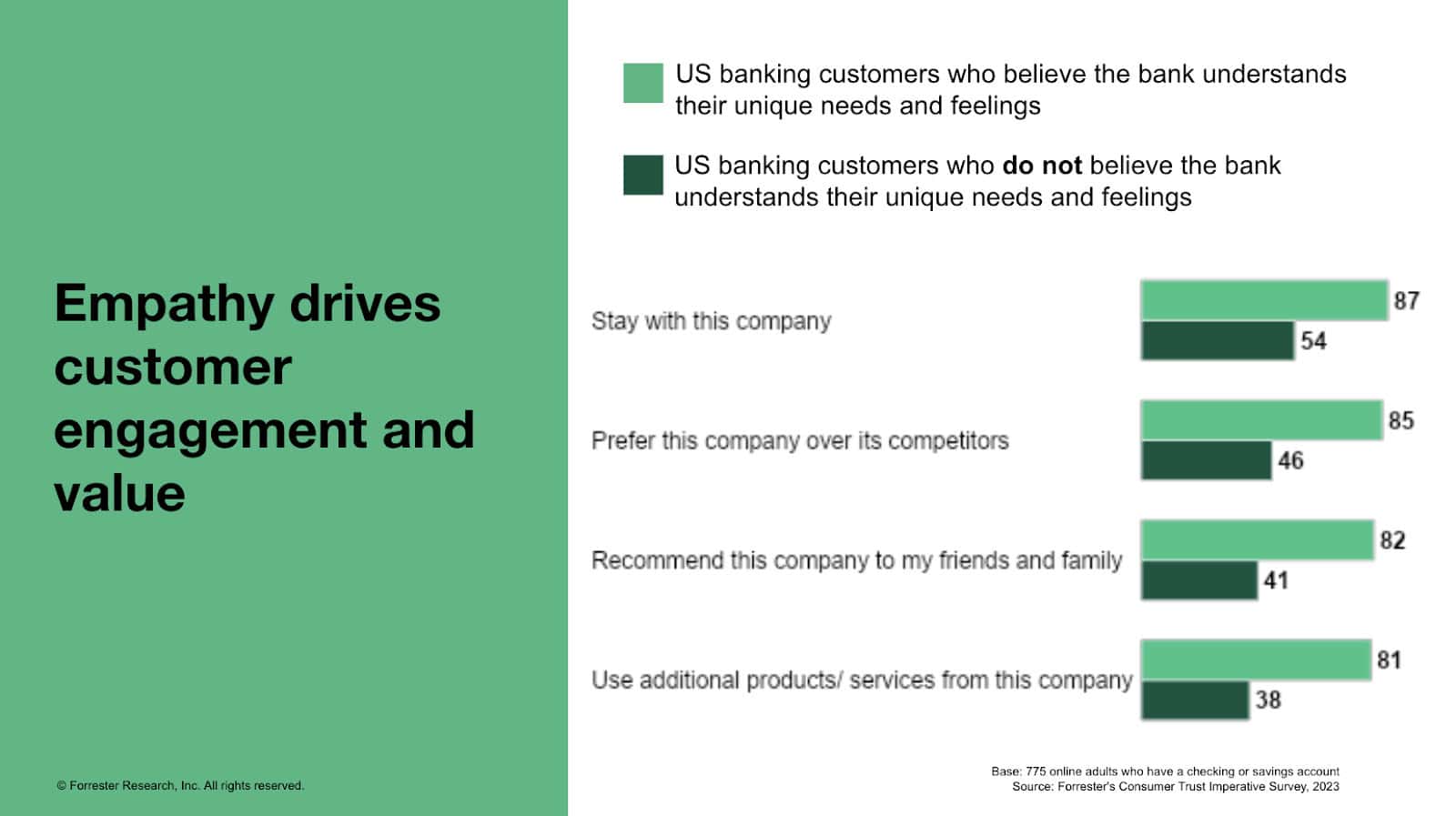
Yet, many businesses struggle with empathy because:
- It’s often treated as a mere step in the design process.
- Empathy practices are often inadequate, relying too heavily on repetitive methodologies.
- Emotional quality is sidelined in favor of ease and effectiveness, with few clear methods or metrics on how to improve or measure emotional quality.
So, how can we keep empathy in focus when creating and designing experiences?
- Immerse yourself in the problem space.
Just putting yourself in the customer’s shoes isn’t enough. The mistake many teams make is simulating what it’s like to be a customer, which only reflects their own assumptions rather than the actual customer experience.
Check out this example of how Mastercard immersed themselves in the problem space and came up with an innovative product to give customers the confidence they need when using their credit card.
- Share insights across your team and organization.
Foster empathy within your organization by:
- Inviting stakeholders to research sessions as active participants.
- Using storytelling, customer videos and verbatims, to convey customer experiences.
- Creating a centralized research repository for easy access to insights.
Now, having the right research toolset is important to do these activities at scale. Senem shared that according to Forrester’s State of CX Teams survey, 63% of CX teams plan to increase investment in experience research platforms, which is an encouraging sign that more teams will gain frequent, direct access to consumer insights at scale.
- Approach customer experience holistically.
A customer’s interaction with a mobile app or website is just one moment in their journey.
It’s a common tendency to focus on only one moment in the experience, but to create truly empathetic moments, consider the broader context of the user.
Journey maps can help visualize the emotional ups and downs of your consumers, keeping you grounded in their context and identifying when empathy matters most.
Can AI foster empathy?
“I don’t think GenAI will replace or should replace real research processes, but I think we should be open to all the benefits and potential it’s offering.”
– Senem Guler Biyikli, PhD of Forrester
“I see GenAI as a tool to help us learn from our consumer connections more efficiently. It’s too time-consuming for one person to review all the feedback and grasp everything, but AI can help us find common themes and uncover opportunities.”
– Sarah Tomasaitis of Suntory Global Spirits
Senem and Share spoke about AI’s potential to accelerate research processes and deepen consumer understanding, with ideas for leveraging AI to:
- Spark ideas during ideation.
Use AI to understand what’s already known about a topic or a customer group you’re researching, and your competitors. Or to draft or refine research plans, interview questions, and discussion guides.
- Summarize and synthesize large amounts of data.
AI can transcribe and summarize interviews, categorize information and determine common themes. - Share research findings effectively.
If you think of your stakeholders or internal partners, you can use AI like an editor, helping you shape your tone or language to your audience for better storytelling. - Show greater understanding to your target audience.
Because GenAI is flexible and adaptable, it’s able to generate more relevant and fluent responses to unique pain points, which helps convey empathy more effectively.
Suntory Global Spirits: Real World Application of Human Centricity
Suntory’s purpose is to inspire the brilliance of life, creating rich experiences in harmony with nature. Their approach to empathy centers on the concept of ‘Gemba’—the scene or place, which involves everyone at Suntory engaging directly with consumers in bars, hotels, restaurants, and retailers – to understand their experiences.
Sarah emphasized, “The more we can get under the hood of the consumer experience, the more we can put ourselves in the footsteps and the shoes of our consumers and understand how to best serve them.”
Despite Suntory’s strong brand reputation, consumer empathy means looking beyond just their immediate interactions with the brand. There’s so much more going on in people’s minds – their passions, their family, their career, and so on.

To gain a deeper understanding of what’s going on in the lives of their consumers today, Suntory recently launched a consumer empathy program. This initiative aims to understand consumers’ lives across various regions, age groups, incomes, and ethnicities with the goal of exploring their passions, changing lifestyles, and how these factors influence their brand choices over time.
At Discuss, we were thrilled to partner with Suntory to tackle the challenges of achieving human centricity on a global scale. They needed a solution that would make it easy for their teams to connect with consumers while overcoming some of the historical hurdles of complexity, high costs, and tedious processes.
With this collaboration, Suntory can quickly engage with consumers one-on-one and build empathy without having to transform everyone at their organization into consumer insights experts. Sarah shared that in just a few months, they’ve seen some fantastic results:
- 10x increase in consumer closeness
- Brand & marketing leaders are using consumer insights to drive business strategy.
- Research repository where all have 24/7 access.
- Anyone, anywhere, can have an instant understanding of key target audiences’ opinions by using GenAI.
We’re excited to help Suntory bring consumers to the heart of their strategic initiatives and make human centricity a reality. To learn more about how we’re making this happen, click here.
Start scaling human centricity today
Sarah and Senem offered their thoughts and advice on how to start scaling human centricity:
- Assess how you are applying empathy right now in your research and design processes.
- Are you making decisions based on customer insights?
- Do you think with empathy across the research and design process?
- Or are you thinking about empathy in only the first phase of the process?
- Review a current experience of your customers with an empathy lens.
Are there certain moments in the customer journey where empathy is more important? What does it mean for your customers to feel heard and understood? - Don’t be afraid to start small.
Identify some champions and run small scale “test and learn” pilots to see how you can infuse more consumer centricity into your processes. You might consider having your insights teams do coaching sessions to guide other business groups on connecting with consumers and best practices.
Conclusion
So what’s the big takeaway? Moving to a human-centric approach means making some key mindset shifts:
- Embrace tools that make it easy: Leverage solutions that incentivize doing more research that don’t charge your “per session” or “per project”, but rather give you unlimited access to your consumers in a cost-effective way that empowers your teams to connect with consumers more often.
- Simplify your processes: Get rid of the red tape at every step that makes it hard to engage with customers. You shouldn’t need to create POs or SOWs every time you want to gather feedback.
- Leverage GenAI to accelerate your time to insights: Move away from the weeks or even months that it can take to synthesize input and use GenAI to quickly analyze and surface insights.
- Consolidate your systems: If you’re juggling multiple systems, it’s time for a change. You need a single, easy-to-use ‘human centricity’ hub that ensures consumer insights are easily accessible across global teams.
At Discuss, we offer a way for organizations to have unlimited access to both the technology and the services you need to make it easy for you to stay close to your consumers. Whether you’re conducting live interviews, asynchronous research or bringing in video files from past research, we give you the tech to easily surface human-centric insights faster than ever before with our suite of GenAI tools.
Feel free to connect with me on LinkedIn to chat about how we can make human centricity a reality for your organization.
About Adam Mertz:
Adam is responsible for leading the innovation, go-to-market, and growth strategies for Discuss. His past 2+ years with Discuss have been focused on driving a culture of obsessing over customer challenges in market research, and innovation that enables customers to rethink what’s possible in scaling qual research. Adam frequently speaks on the new era market research is now in. In a recent TMRE@Home virtual webinar, he spoke with Sioned Winfield of PepsiCo about the innovative approaches and technologies PepsiCo is using to overcome the historical challenges of scaling human centricity on a global level and seamlessly integrate human voices into their processes.
Ready to unlock human-centric market insights?
Related Articles

Why Your Business Needs a Multicultural Marketing Strategy
A recent Ad Age article highlights a notable trend that some companies are taking a stand to keep DEI at…
A recent Ad Age article highlights a notable trend that some companies are taking a stand to keep DEI at…
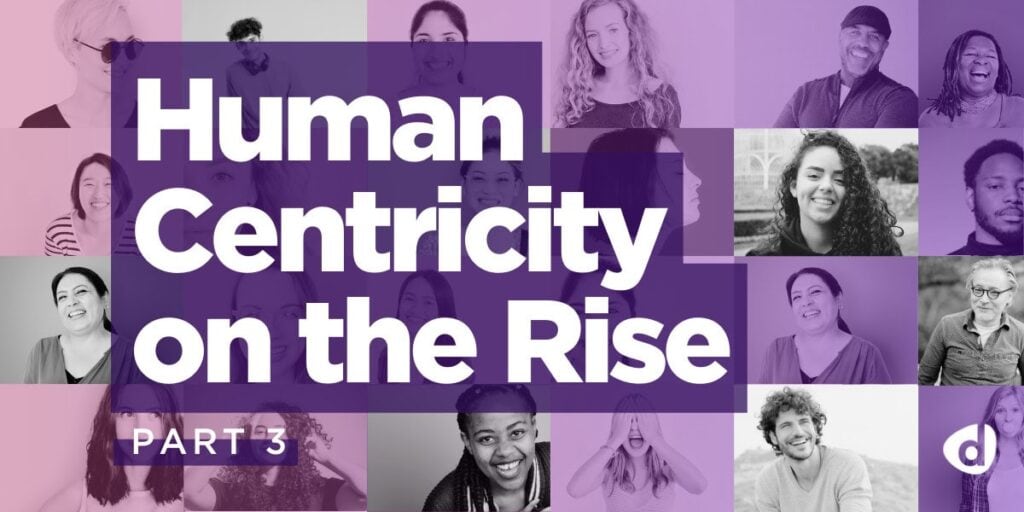
Human Centricity on the Rise: Navigating the New Era, Part 3
How to unlock human centricity at scale with a key mindset shift In Part 1 of this blog series, I…
How to unlock human centricity at scale with a key mindset shift In Part 1 of this blog series, I…
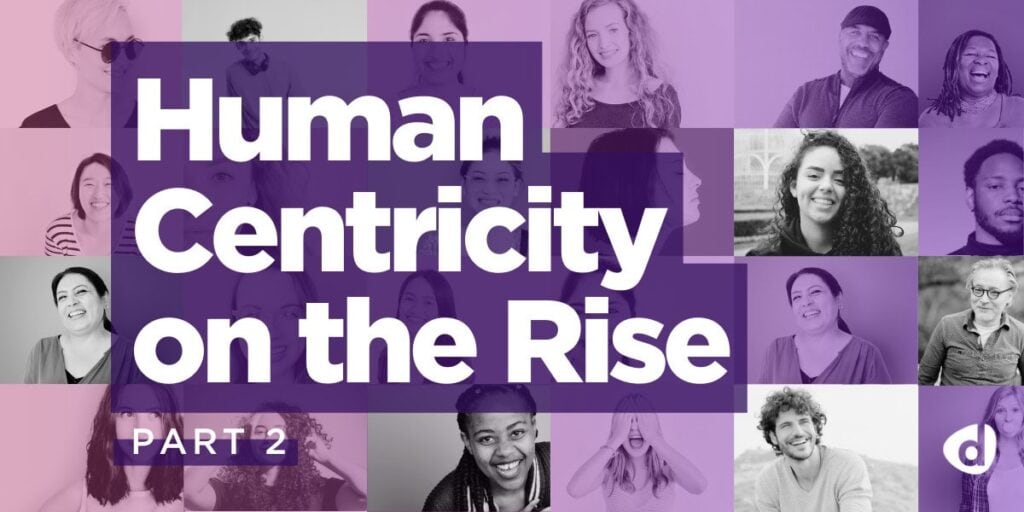
Human Centricity on the Rise: Navigating the New Era, Part 2
Explore the strategies driving success as global leaders prioritize human centricity in future-proofing consumer insights In the first blog of…
Explore the strategies driving success as global leaders prioritize human centricity in future-proofing consumer insights In the first blog of…

